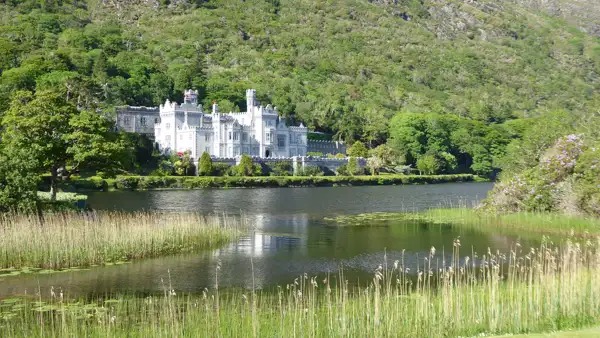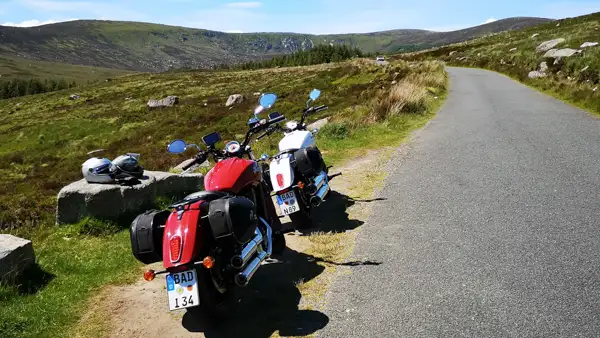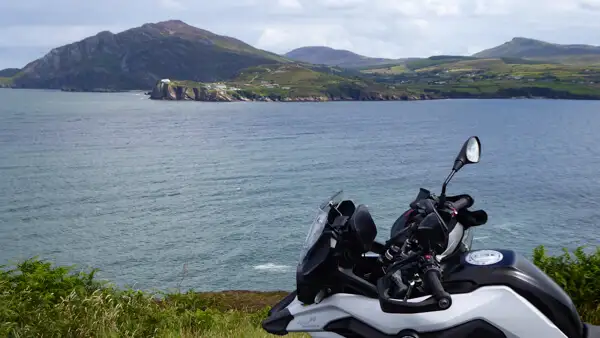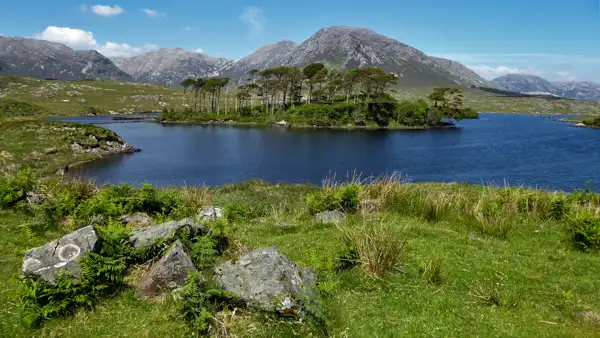The holiday is approaching, the flight or ferry is booked, but the planning is not yet in place? Anticipation is mixed with uncertainty – actually I don’t have the time, but without planning it might not be good either…
Page Contents (click line to jump the text)

Intro
Here are a few tips from my own motorbike trips in Ireland – and from many conversations with our customers. We have (update: had) a motorbike rental business in Ireland and many of our customers tell us about their experiences, the original planning, and what they learned along the way.
How much time do I have?
This is extremely important, because if you only have 4 full days to drive, I wouldn’t recommend going to the west coast at all, but stay in the east. You need one day there and one day back.
In one week you can do half of the Wild Atlantic Way (north half or south half), for the whole WAW I would calculate about 11 days and once around the island I would estimate 14 days.
Your time budget already leads to a pre-selection of the route.
Where do I start and end my Ireland tour?
Calculate your arrival and departure realistically – usually these are not full driving days. When will the plane arrive, when will I have my luggage, when will I be on the bus or in a taxi,…., when will I realistically be on the motorbike?
If you are travelling with your own motorbike: How much distance do you plan to cover on the first day and how much on the last? If the ferry was rough, you won’t want to ride long after you land, believe me….
If you land in Rosslare but depart from Dublin again, what does that mean for the route choice – should you go left round or right round the loop?
Most people overestimate the distance they can ride on arrival day or departure day – plan the two days as short riding days.
What time of year do I choose and what will the travel weather be like?
Not only motorcyclists are very dependent on the weather, but also the ferries! If it gets stormy, they may not run for a day or more.
You can rebook, but success depends on availability – one day later, or three days later?
Storms are rare in summer, but they can be more frequent in early spring and later autumn. Ireland is, after all, an island in the Atlantic!
Planes are usually less susceptible than ferries and almost always fly.
What will the motorbike weather be like? Your weather app will tell you – but of course that’s fraught with uncertainty. Be prepared for cool, wet weather and be happy when it does get dry and warm.
Daytime temperatures in the summer months tend to hover around 18-20 degrees, but it can also be 25-29 degrees, or sometimes as low as 12 degrees.
What does that mean? If you have a lot of time, take the ferry, otherwise flying and renting a motorbike locally might be a good alternative. Plan your clothing so that cool, wet days don’t get you into trouble.

How many kilometres should I plan per day?
Here comes the biggest surprise for most: You should only plan 200-250km per day. Most of our clients are in this range.
Why? Irish country roads are mostly small and narrow, lined with hedges and walls that obstruct your view into the bends, oncoming traffic likes to cross the centre line, plus poor road surfaces, dirt from farming, rolling gravel from road construction and animals on the road.
Oh yes, we also have left-hand traffic – not everyone is used to it…
The speed limit is 80km/h (R and L roads), but often 65km/h already feels breathtaking.
So it’s all terrible? No not at all, just drive slowly and everything is fine!
But you’ll do less kilometres than you might expect. A few more breaks and a little sightseeing and then we’re at 200-250km per day.
Do I need break days or reserves? Or a sightseeing tour?
Skiers know that on the 3rd or 4th day at the latest, the falls come. In the beginning you are driven by adrenalin, but after a while a little exhaustion sets in.
Double overnights provide relaxation. The moto junkie goes on a short tour without luggage the next day, after a good night’s sleep and a late breakfast.
Meanwhile, the pillion rider takes a look at Galway – in peace and quiet. Taking a day off brings relaxation. Well rested, we can continue the next day.
So yes, planning a bit of spare time is a very good idea!
Which sights do I want to see?
Travel guides, Google Maps, YouTube, social channels – get inspiration and see what interests you.
One person just wants to drive – include the mountain ranges in the tour. The other loves castles and palaces – and is spoilt for choice.
You are not a city person? Forget Dublin, Cork or Galway. But there are also really nice colourful small towns in Ireland.
Mark your must-see locations on a map and see if that leads to a nice tour.
Where is the most beautiful place in Ireland?
The Irish island is an island – that’s for sure. It impresses above all with its coasts.
The Wild Atlantic Way has many truly breathtaking stretches of coastline and is therefore certainly the most important highlight for motorbike travellers in Ireland. But you don’t have to ride it all the way, because that’s over 2500km.
You can also do a week of WAW (about half) and then add a few city days – before, after or on the way. On the way there or back you drive through the hilly inland and that has its charms too.

Should I book accommodation beforehand?
The short answer is: Yes!
In the summer months, accommodation is often fully booked, especially on the coast, but also in Dublin. It is therefore advisable to book in advance.
In spring or autumn there are more opportunities to find a nice place to stay at short notice, but even then I would book at least one day in advance to avoid having to spend the day driving around looking for accommodation.
I usually use the app from booking.com, many of our clients also use Airbnb, and I usually look for the accommodation for the next day during dinner.
Determine” the route – but remain flexible
Staying flexible is an important travel resolution, because first things happen differently than you think. When I book accommodation, I make sure that I can cancel at short notice and that I can react if problems arise.
I once sat out a heavy autumn rainstorm in the Scottish Highlands for three days because driving was out of the question. Did that change my plans? Yes. Was it bad? No.
It doesn’t have to be the storm, a flu-like infection can have the same effect.
Even simpler: the route is too long or too short and I want to change it on the way – it’s better than getting angry about it every day.
Your plan is just a plan – nothing more.
How do I find my way around: navigation device, maps or smartphone?
Oh dear – I have already experienced hours of discussion on this topic. let’s approach the subject as objectively as possible:
Map in the transparent lid of the tank bag: Good overview for planning the trip, you get a good feeling for the dimensions of the country, the cardinal directions of the stage destinations and you can easily imagine the course of the terrain. But: The map sheet has to be constantly refolded, the most important place is always in the crease and at some point the map gets wet and tears. There are also foiled motorbike maps that work quite well.
Motorbike navigator on the handlebar: Tomtom or Garmin? A religious war. Our rental motorbikes are all equipped with the Tomtom Rider 550 and our customers almost all get on well with it. They would probably also get along well with Garmin (BMW Navi).
No matter which one: motorbike sat navs are very shockproof, waterproof and robust. They charge from the motorbike battery and are usually easy to read in both rain and sun. You will find all important and larger places, but not necessarily the private homestay you booked on Airbnb – you will need your smartphone for the last few metres.

Motorbike navigator on the handlebar: Tomtom or Garmin? A war of faith. Our rental motorbikes are all equipped with the Tomtom Rider 550 and our customers almost all get on well with it. They would probably also get along well with Garmin (BMW Navi).
No matter which one: motorbike sat navs are very shock-resistant, waterproof and robust. They charge from the motorbike battery and are usually easy to read in both rain and sun. You will find all important and larger places, but not necessarily the private homestay you booked on Airbnb – you will need your smartphone for the last few metres.
Smartphone in cradle on handlebars: I love Google Maps for trip preparation or for researching intermediate destinations. Even if the navigation system doesn’t know my destination, I use my smartphone for the last few metres. Others plan their trip completely with the Calimoto app or other apps and then ride it with the smartphone. Good smartphones are very waterproof, but not necessarily very shockproof. Constant shaking can damage them, especially the connection to the charging cable. They also get very hot during prolonged navigation – which can’t be good for the durability of the expensive device in the long run. If your smartphone falls out of the cradle on the road, what is your backup? For me, the smartphone is the backup for the motorbike sat nav.
A combination: map for the overview and smartphone for driving, or sat nav for driving and tablet for planning, or map for planning and driving and smartphone as backup – there are several possibilities. Choose the combination that works best for you!
Other electronics
You can also listen to smartphone or sat nav instructions via a com device on your helmet, make phone calls on the side, select music, radio with group members, operate the Gopro and the drone. Some of our customers who started to set up their electronics on the farm switched them off after a few metres – they had to deal with the left-hand traffic and the unfamiliar road conditions.
And that is exactly the recommendation I give: Keep it simple – and don’t forget to ride a motorbike!
Conclusion
Whether you ride with a map on your tank bag, use a motorbike navigation system, use your smartphone with Google Maps or other apps, or find a completely different solution is basically irrelevant. Each of the options has its advantages and disadvantages, the important thing is that you feel comfortable with your chosen means and get on well with it. But you will need some kind of solution!
If you don’t get on well with your navigation, you’ll be at risk of constant distraction and frustration – neither of which are good companions on a motorbike journey. A new sat nav can be a good investment in your safety – and riding enjoyment.
More importantly, choose your daily stages realistically, and in Ireland they are usually shorter than most riders would expect. And if you are already on the last metres to the next overnight stop in the early afternoon? Then just add another loop – that’s always possible!
Despite all the planning, know that your plan can change – and that’s often a good thing!
The must-see attraction is not exciting at all? Never mind, keep going! On the third day you want to lie on the beach for a few hours because the sun is shining so nicely? Do that and cut the rest of the day short! Missed the castle? There are more to come…
In the end, it’s the holiday that counts – not whether you’ve implemented your plan 100%. You can safely leave the stress at work.
Have fun planning – and even more fun implementing – your motorbike tour in Ireland. And if you are still looking for a rental motorbike for your trip, you can find us here: www.easycruiser.tours.
More interesting articles for you
PREPARING YOUR BIKE FOR A TRIP TO IRELAND – BE WELL PREPARED AND SAFE ON THE ROAD!
LEFT-HAND TRAFFIC – WHAT SHOULD I KNOW AS A MOTORCYCLIST?
MOTORBIKE TRIP IRELAND – WHICH REGION SHOULD I GO TO?
EXPERIENCING IRELAND BY MOTORBIKE, OR: THE REDISCOVERY OF SLOWNESS
Photo credits cover photo: Ulrich Knüppel-Gertberg (www.irland-insider.de, www.ireland-insider.com)